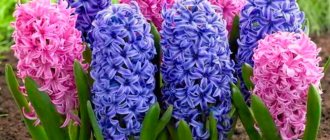Usually with a balanced and reasonable approach Growing orchids does not bring any particular difficulties or headaches.
However, even in this matter there are subtleties and differences, the observance of which will increase the gardener’s chances of success - luxurious flowers. And if you approach the matter in an unscrupulous and careless manner, then you will have to wait a very, very long time for flowering.
Species suitable for cultivation
Unfortunately, not all species of this family are suitable for cultivation at home, being delicate and sensitive to the growing climate zone, which plays a crucial role when choosing a pet. Therefore, from the entire variety of orchids, it is worth choosing those whose cultivation will not be associated with special conditions, the creation of which is simply impossible at home.
One of the best species is Phalaenopsis . It blooms for a long time and beautifully, for which it is highly valued by gardeners. It pleases with a variety of shades and fits well into the interior of apartments.
Also a good choice would be the Cattleya orchid, known for its aerial roots, the Vanda orchid, whose large flowers become increasingly brighter in color over time, the Dendrobium, which pleases the eye with its monthly flowering, and the Zygopelatum, which amazes with its multicolored petals and exquisite aroma.
Orchid does not bloom - what care is needed
The blossoming of an orchid is the most joyful moment in the life of any gardener. The orchid blooms at the age of 1.5-2.5 years. It can be very difficult to wait for it to bloom. It would seem that you are caring for her with all your might, but she, ungrateful, does not want to blossom. And you leave her alone! An orchid needs a little stress to produce a beautiful flower. A sharp temperature change can speed up flowering. For example, keep the whim all night at a temperature of +18C, and in the morning move it to a warm room. A reduction in watering can also serve as an impetus for flowering. In winter, there is no point in driving out an orchid at all - it is better to put it in a cool place, let it wait there for spring. published
Author: Regina Raitova PS And remember, just by changing your consumption, we are changing the world together! © econet
Join us on Facebook, VKontakte, Odnoklassniki
Growing methods
The methods of growing orchids are very diverse, but each of them is unique in its details and stages. The secrets of the life cycles of their favorite plants are revealed before the eyes of professional gardeners, amateurs and beauty connoisseurs. Let's look at some of them.
You can get a full-fledged plant from seeds only by using special media (for example, agar-agar), which are sold in specialized stores. Following the instructions, the seeds are planted and the conditions are monitored. If everything is done correctly, the result will be positive (read more about how to grow an orchid from seeds).
Important! The seeds are planted in sealed jars and they germinate only after 9 months.
You can also get an orchid from bulbs, also called bulbs. Pseudobulbs are cut off from them and planted in moss, having previously been rubbed with coal.
Another way is to grow from shoots. As soon as its length reaches at least 3 centimeters, it is cut off with a disinfected tool and wrapped in damp moss. When, after their appearance, the roots grow to 5 centimeters, it will be possible to strengthen the young plant on the substrate.
Pests
Spider mites are one of the most common pests that can destroy an orchid without proper action. The problem can be solved with a special product that can be purchased at any flower shop.
The next pest is mealybugs. They can be identified by a gray coating on the leaves. The first aid to combat them is to use a soap solution. Gently wipe the leaves, being careful not to get into the middle of the buds.
For plants with a greater degree of damage, use the drug Fitoverm. After dissolving it in water according to the instructions, spray it. Repeat after a couple of days to consolidate the effect.
Orchid pot: how to choose the optimal pot. Features of planting orchids with your own hands (145 photos and videos)An orchid's roots dry out and rot - what to do and how to revive a drying flower. 125 photos and video instructions for restoring orchids
Orchid does not bloom at home: reasons, treatment methods and advice from gardeners on stimulating the plant (125 photos and videos)
If the spider mite and gray coating of the mealybug are not observed on other plants, then most likely you brought it from the store.
Preparation for cultivation
In order to grow an orchid at home, you should thoroughly prepare for this, since only special conditions, thoughtfully and painstakingly created, will lead to success.
Capacity.
This is the first thing you need to prepare. It should be taken into account that orchids grow poorly or not at all in an ordinary pot, which means they need special vessels. All over the world, three options for containers for growing orchids at home are preferred:
- Transparent plastic containers with holes on the sides and bottom for free air access to the roots.
- Clay pots. Drainage and substrate composition will be important here. Not all types of orchids are ready to grow in such pots.
- Wicker baskets. They themselves are ready for good aeration; also, their ease and convenience speak in their favor.
Priming
Soil for orchids is qualitatively different from simple garden soil, so its choice should be approached with skill and care. The life of the flower, its development and ability to reproduce will depend on its quality.
Important! Properly selected soil provides oxygen supply and removes excess moisture from the roots, which avoids rotting.
Beginners should purchase a ready-made mixture. Ready-made substrates are sold in specialized stores. Experienced gardeners will find it easy to make their own soil. The following fillers are suitable for this:
- Peat
- Tree bark
- Coarse sand
- Sphagnum moss
- Charcoal
Their ratio may be approximately the same.
Important! The moss should be placed on top of the substrate to retain a small amount of moisture.
The starting materials must be crushed and well dried. A special role is played by the drainage system, which should occupy from 3 centimeters to a third of the entire container. When using a basket, drainage is not always required.
Orchids and air
In nature, orchids are epiphytes, that is, they grow on trees where air circulation is much higher than on the ground. Therefore, in stuffy, unventilated rooms, orchids grow poorly and bloom worse. If you are interested in making your orchid happy in your home, create a little air movement. But not a draft - orchids don’t like it, they quickly drop their flowers. Professional orchid growers periodically (for an hour or two) turn on a weak fan in the room with orchids, not directed at the flowers.
As for the air temperature, the overwhelming majority of orchids come from southern countries and love warmth, so the optimal temperature for their maintenance and care is +20C-+25C. And if the temperature drops to 17 degrees and below, the chance of seeing an orchid bloom is minimal.
Temperature
It will be optimal to keep the flower at 20-28 degrees. Orchids at home prefer a clear boundary between day and night temperatures. The difference should almost always range from 5 to 7 degrees. In order to stimulate flowering, it is worth reducing the temperature to 12-17 degrees.
Important. Exposing a flower to low temperatures is unsafe and even fatal.
Lighting
Growing and care require compliance with the light regime for this beautiful flower, which primarily concerns the location. The south and southeast sides are the most convenient and favorable for orchids. It is important to remember that direct sunlight can greatly dry out your pet, so a translucent filter or light shade is recommended.
Side lighting is also considered very suitable for successfully growing orchids, although this is more difficult at home than in a greenhouse. If there is not enough light, you need to take care of an additional source.
Watering
In principle, home care allows the orchid to survive without water for up to 2 weeks. But, most often, the watering regime in the warm season is once every 3 days, in the cold season – once a week. For delicate tropical creatures, use filtered, rain, boiled warm water. Under no circumstances should water stagnate in the container.
Particular attention should be paid to the manner of watering, since this must be done, trying not to touch the flower or get into the inflorescences. Or immersion in water is carried out for a period of up to half an hour.
Important! The plant can be sprayed, but moisture should not get on the inflorescences. If this cannot be avoided, they need to be wiped.
Feeding
Liquid fertilizers are used once every 3-4 weeks. Fertilizers containing nitrogen are excellent. Active growth and flowering are ensured by systematic nutrient application procedures. Fertilization processes should be activated during the active phases, and when growth stops, stop, resuming when the peduncle is activated. Next, feeding can be suspended and the breeding process can begin.
Orchid lighting
Orchid is a very light-loving plant. The availability of the required amount of light determines whether the orchid will bloom and for how long. But at the same time, she cannot stand the bright midday sun. So it is better to place the pot with the beauty on a western or eastern window. If this is not possible, provide the flower with additional light. You can determine how an orchid is feeling by looking at its leaves - if they have become very dark, then there is not enough light, and if they turn yellow or become covered with spots, then you have too much light.
Reproduction
There are many ways to propagate indoor flowers. The most suitable method for orchids is cuttings.
To achieve a positive result, you need to bring the flower into comparative balance. For example, after the end of the flowering phase, you can quarantine (about 30 days), observing stable temperature and light conditions. Then, using a sterile instrument, cut the shoot up to 15 centimeters in length and lay it on the substrate. An excellent solution would be to create greenhouse conditions.
Such conditions are easily created using a plastic container and cling film, of course, at a constant temperature of at least 25 degrees; after the roots appear, the sprouts can be transplanted into a pot. It is also important to comply with the drainage height conditions to allow for aeration and removal of excess moisture.
In this article we described how to grow an orchid at home. Detailed information on each type can be found in separate articles.
Transfer
Sympodial orchids (with the exception of Ascocenda, Vanda and Phalaenopsis) produce new shoots every year, the number of which depends on how strong and healthy the plant is. Therefore, after a while the pot will become cramped. Phalaenopsis roots are quite thick and grow quickly, filling the pot. This is why it becomes too crowded after a while, threatening the health and stability of the plant.
“Ready soil” for orchids. Trust but check! IF YOU want to use a ready-made soil, choose one that has a high pine bark content, no soil AND very little compost! To check the composition, take a little mixture into your hands; they should remain clean. IF YOU find small organic particles in it, rinse it in a colander.
Transplantation is necessary:
- when the roots completely fill the pot;
- when the beneficial properties of the substrate are depleted;
- if the orchid is “flooded” with water (due to insufficient drainage) and the roots begin to rot.
Most orchids are replanted every 2-3 years. But paphiopedilum, for example, prefers annual transplantation. It is best to do this after flowering, when young shoots appear. Avoid transplanting in hot weather, as well as in November-December. If your orchid has bloomed during this period, wait until spring. Never replant a plant during flowering, even if it seems to you that it is already cramped in the old pot.
How long does it take to grow?
The peduncle can develop from 1.5 to 5 months before the first bud opens, depending on the type of orchid, peduncle and conditions of detention. A regular peduncle of phalaenopsis is formed in 2 months, a lateral peduncle is formed faster in 1.5 months. On average, an orchid blooms for 3 months.
If the orchid has already bloomed, then there is no need to immediately cut the stem . The peduncle from the first growth point is formed faster than the one that is formed anew. Often, new buds in an orchid form when stress occurs: a slight drought or a drop in temperature.
Distribution in the world
When purchasing a beautiful flower in a store, we cannot always even imagine the habitats of orchids. Where do they grow?
There are many types of orchids - about 35 thousand. They are so different. And their natural habitats are far from identical. Even very different. So what is their difference?
Representatives of orchids surprise not only with their beauty and originality. But also with its ability to survive in different climates:
- Hot and harsh;
- Rainy and dry;
- Forests and steppes;
- Mountains and plains.
Continents are easier to list. And we can say that all continents. Except for one thing - Antarctica. But it will take a long time to name the countries. Next we will name some.
Tropical epiphytes
The word epiphyte itself means a plant growing on another plant. Or attached to another plant - phorophyte. This is how they grow:
- On trees (branches and trunks);
- On stumps and snags;
- In the crevices of stones;
- And even on steep cliffs.
Such plants live off moisture, air and bark residues. Their roots are also called aerial:
- With their help they are attached;
- These roots absorb moisture from the air and wet surfaces of the tree;
- And they also participate in the process of photosynthesis.
Herbaceous species of temperate latitudes
Can such an orchid grow in the ground? Let's just say that they cannot do without soil . They have underground rhizomes or tubers. They find a peculiar soil - breathable and moisture-permeable pieces of bark, stone chips, roots.
Some species are found on the surface of the earth in layers of fallen leaves, branches and bark of trees, overgrowth of moss and small stones. Such orchids have few leaves. Quite often - only one.
Conditional division by climatic latitudes
The diversity of orchids required some analysis and systematization. They are divided into five subfamilies:
- Herbaceous perennials. Each of them includes many tribes: Apostasiaceae;
- Cypripediaceae.
- Vanilla.
- Epidendral.
- Orchids or Orchidaceae.
There is also a division by climatic zones and territories. It's more conditional. And includes four groups:
- Tropics. Bright and ventilated places near rivers. On the slopes of the mountains. Epiphytic species grow predominantly: Coast of Africa, South and Central America, eastern and northern Australia;
- Adjacent areas of the Amazon and Congo rivers.
- Foothills of the Himalayas;
- Highlands and arid zones. With their temperature variations (hot days and cold nights), they are suitable for many types of terrestrial orchids. And some epiphytic ones. And they grow near rivers and reservoirs.
- North America;











